class: center, middle, inverse, title-slide # Moral reasoning ## Week 3 - Moral Psychology --- # Week 3 This week we will be discussing we reason through moral dilemmas and judge behaviors as right or wrong .highlight-blue[In week 3:] - **How do we determine which course of action is right in a moral dilemma?** - **What moral principles do we typically use to justify our moral judgments?** - Do moral judgments arise from a deliberate, conscious process, or an automatic, unconscious one? --- # The rationalist model .footnote[Haidt (2001)]  - Conscious reasoning determines moral judgments - Emotions (e.g., sympathy, disgust, anger) are sometimes used as input to guide conscious reasoning ??? In this model, a person is completely rational. In order to make a judgment, individuals reflect and reason through the evidence carefully, thinking about whether the action is fair, whether it harmed anyone, etc. --- # Moral reasoning Psychologists study moral reasoning primarily through moral dilemmas - A **moral dilemma** is a moral situation where an individual has to choose between two conflicting moral principles -- For example, the following scenario pits two moral principles against each other: do not kill and do not allow someone to suffer >A doctor must decide whether to kill a dying patient who is asking for an end to her suffering. The most studied dilemma in moral psychology is .highlight-blue[the trolley dilemma] ??? By changing small pieces of information, we can better understand how we make moral decisions --- # The trolley problem .footnote[Foot (1978)] .left-column-big[####The switch case 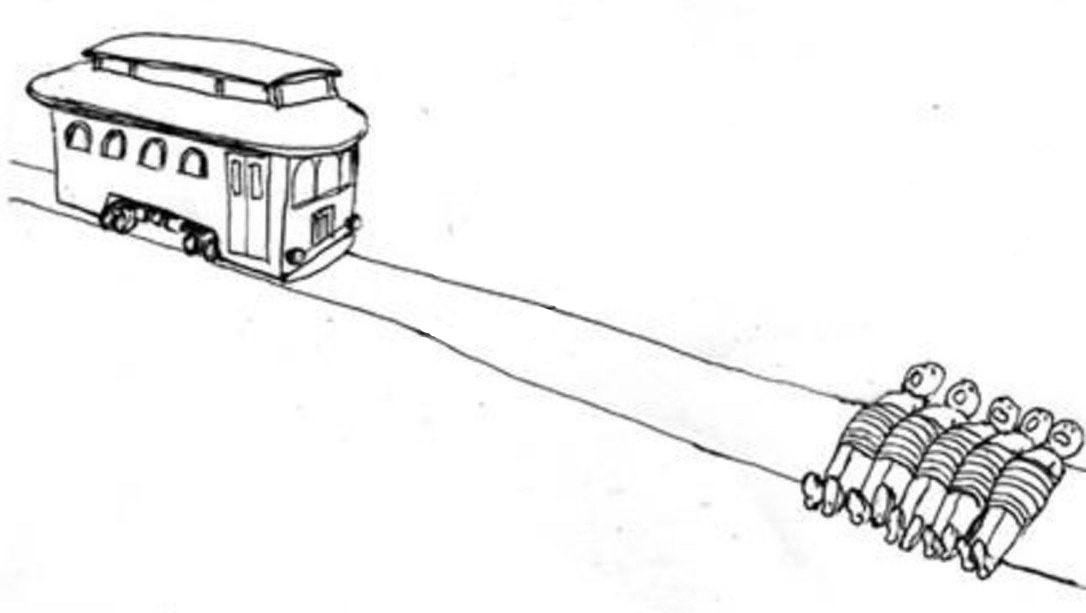] .right-column-small[ *A runaway trolley is barreling down a set of train tracks. There is unfortunately no conductor to stop the train, which is about to run over and kill five people...*] --- # The trolley problem .footnote[Foot (1978)] .left-column-big[#### The switch case ] .right-column-small[ *You are standing to the side of the track. Next to you is a lever. If you pull the lever, you can divert the train onto an alternate track where it will kill one person instead of five. **Should you pull the lever?***] ??? Moral dilemma: kill 5 people with inaction or kill 1 person with action? Have students raise their hand and write it on the chalk board Can ask why --- # The trolley problem .footnote[Foot (1978)] .left-column-big[#### The footbridge case ] .right-column-small[ *A runaway trolley is barreling down a set of train tracks. There is unfortunately no conductor to stop the train, which is about to run over and kill five people...*] --- # The trolley problem .footnote[Foot (1978)] .left-column-big[#### The footbridge case 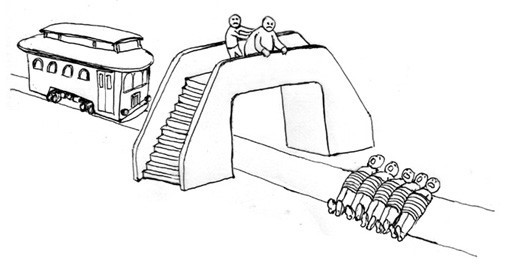] .right-column-small[*You are standing on a footbridge overlooking the train. Next to you is a heavy gentleman. If you push the man off the bridge, you can stop the train, which will kill one person instead of five. **Should you push the man?***] --- # The trolley problem .footnote[Hauser et al. (2008)] - Studies have found that about 90% of people say they would pull the lever in the first scenario but only 10% say they would push the man in the second scenario - The normative philosophical theory *utilitarianism* says that what we ought to do is what will benefit the most people, and pushing the man off the bridge is what is best for the most number of people -- .dq[Why don't we want to push the man off the bridge?] ??? Emphasize that the consequences are the same 1 dies and 5 live --- # The trolley problem .footnote[Greene et al. (2009)] There are many differences between pulling a switch to save five people and throwing someone off a bridge to save five people - **Physical contact**: you do not need to touch the victim (switch) vs. you do need to touch the victim (bridge) - **Personal force**: you do not need to apply personal force to the victim (switch) vs. you do need to apply personal force to the victim (bridge) --- # The trolley problem .footnote[Greene et al. (2009)] There are many differences between pulling a switch to save five people and throwing someone off a bridge to save five people - **Spacial proximity**: you are far away from the victim (switch) vs. you are close to the victim (bridge) - **Intention**: harm is a foreseeable but unintended side effect of achieving the greater good (switch) vs. harm is a means to a greater good (bridge) --- # The trolley problem .footnote[Greene et al. (2009)] **Research question**: Why do people refuse to push the man off the bridge? **Method:** Researchers gave participants four different variations of the trolley dilemma - The standard footbridge<br> - Footbridge pole<br> - Footbridge switch<br> - Remote footbridge --- # The trolley problem .footnote[Greene et al. (2009)] .left-column-big[#### (a) The standard footbridge 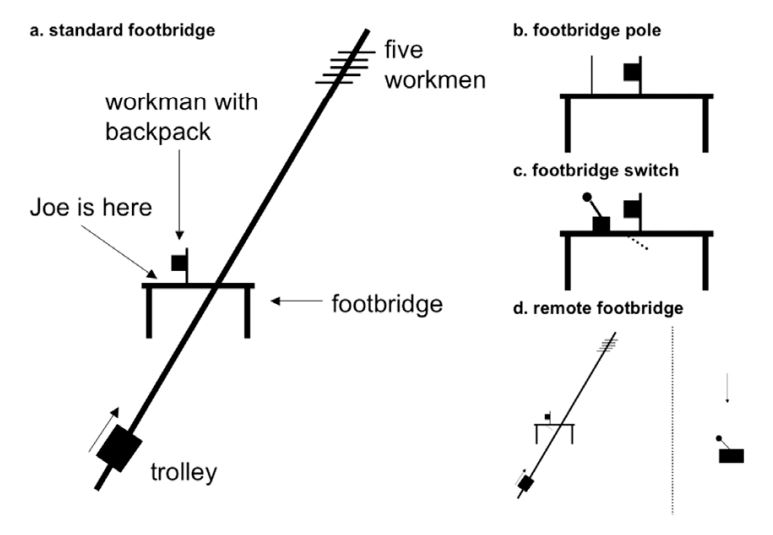] .right-column-small[<br><br> *Should Joe push a man off the bridge to save five?*] --- # The trolley problem .footnote[Greene et al. (2009)] .left-column-big[#### (b) Footbridge pole ] .right-column-small[<br><br> *Should Joe use a pole to push the man off the bridge to save five?*] --- # The trolley problem .footnote[Greene et al. (2009)] .left-column-big[#### (c) Footbridge switch ] .right-column-small[<br><br> *Should Joe pull the switch to open a trap door that will drop the man off the bridge?*] --- # The trolley problem .footnote[Greene et al. (2009)] .left-column-big[#### (d) Remote footbridge ] .right-column-small[<br><br> *Should Joe pull the switch to open a trap door that will drop the man off the bridge (this time he is far away from the man)?*] --- # The trolley problem .footnote[Greene et al. (2009)] || |Personal force|Spatial Proximity|Physical contact| |---||----|----|----| |The standard footbridge |.tiny-picture[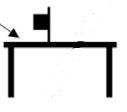]|<center>**.green[✓]**|<center>**.green[✓]**|<center>**.green[✓]**| |Footbridge pole|.tiny-picture[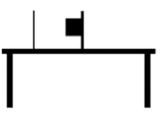]|<center>**.green[✓]**|<center>**.green[✓]**|<center>**.red[✗]**| |Footbridge switch|.tiny-picture[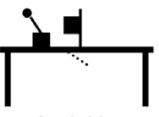]|<center>**.red[✗]**|<center>**.green[✓]**|<center>**.red[✗]** |Remote footbridge|.tiny-picture[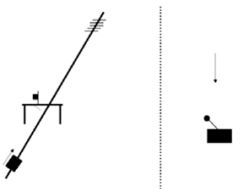]|<center>**.red[✗]**|<center>**.red[✗]**|<center>**.red[✗]**| ??? You can compare pairs of moral acceptability ratings to determine if personal force, spatial proximity, or physical contact are important factors Personal force: compare footbridge poll and footbridge switch Spatial proximity: compare footbridge switch and remote footbridge Physical contact: compare standard footbridge and footbridge poll --- #The trolley problem .footnote[Greene et al. (2009)] #### Results .right-column-med[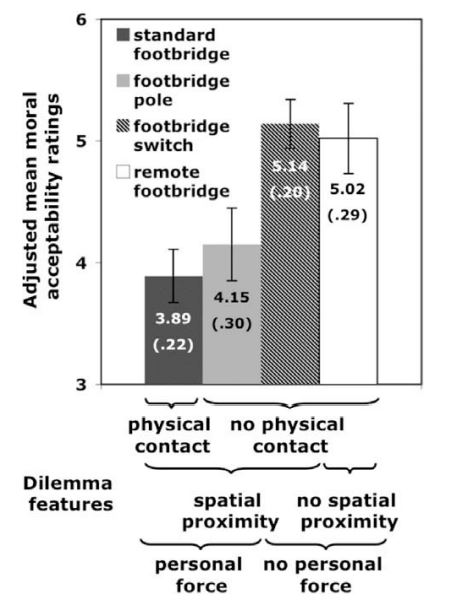] - **Personal force** was rated as less morally acceptable than no personal force, regardless of physical contact/ spatial proximity - Pushing the man off the bridge with your hands or with a pole was considered *less morally acceptable* than doing so with a switch and trap door ??? - Participants rated the extent to which choosing to harm the one person to save the five was "morally acceptable" Individuals judged actions that required personal force (pushing off the bridge with hands or a pole) as less morally acceptable than actions that did not require personal force (the switch cases), regardless of if Joe touched the victim (physical contact) and regardless of if the individual was close or not (spatial proximity) --- # The trolley problem .footnote[Greene et al. (2009)] .left-column-big[ #### The loop case *A runaway trolley is barreling down a set of train tracks. There is unfortunately no conductor to stop the train, which is about to run over and kill five people...* ] .right-column-small[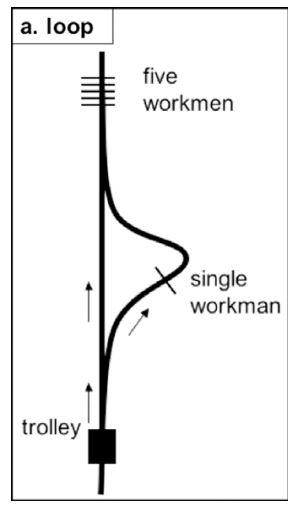] --- # The trolley problem .footnote[Greene et al. (2009)] .left-column-big[ #### The loop case *Joe may save the five by pulling a lever to turn the trolley onto a looped side track and towards a single workman instead. Hitting the workman will stop the train from hitting the five people.* ] .right-column-small[] --- # The trolley problem .footnote[Greene et al. (2009)] .left-column-big[ #### The loop case *Joe may save the five by pulling a lever to turn the trolley onto a looped side track and towards a single workman instead. Hitting the workman will stop the train from hitting the five people.* .dq[Should you pull the lever? Why or why not?] ] .right-column-small[] ??? Note here that people condemn this but it doesn't require personal force --- # The trolley problem #### The doctrine of double effect It is sometimes acceptable to cause harm .highlight-blue[as a side effect] of doing something morally good, as long as you are not causing harm as a means to an end -- - **Intention** is also an important consideration - *Is killing the person an unfortunate side effect (like in the original switch case) or are you **using** the person to stop the train (like in the footbridge or switch cases)?* --- # The trolley problem .footnote[Greene et al. (2009)] **Research question**: In the absence of personal force, why does it feel wrong to use a person to stop the train? **Method**: Participants were given four more variations of the trolley dilemma - The loop <br> - The loop weight <br> - The obstacle collide <br> - The obstacle push --- # The trolley problem .footnote[Greene et al. (2009)] .left-column-bigger[#### (a) The loop 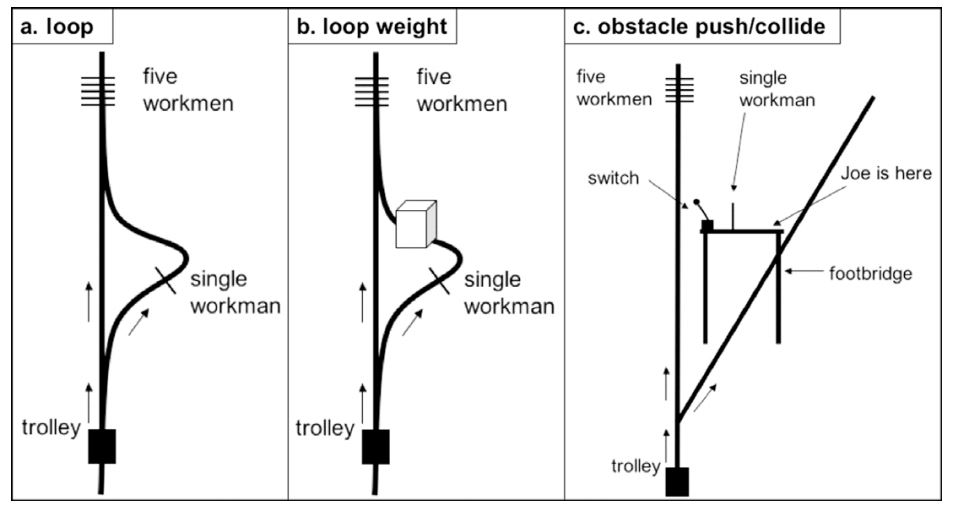] .right-column-smaller[<br><br> *Hitting the workman with the trolley would effectively stop the trolley from hitting the five people at the end of the tracks.*] --- # The trolley problem .footnote[Greene et al. (2009)] .left-column-bigger[#### (b) The loop weight ] .right-column-smaller[<br><br> *Identical to the loop but there is a heavy weight positioned behind the victim. The weight stops the trolley, not the victim.*] --- # The trolley problem .footnote[Greene et al. (2009)] .left-column-bigger[#### (c) The obstacle collide ] .right-column-smaller[<br> *The individual is on a bridge and needs to redirect the train from hitting five people. On his way to the switch, he accidently collides into a workman and he falls to his death.*] --- # The trolley problem .footnote[Greene et al. (2009)] .left-column-bigger[#### (c) The obstacle push ] .right-column-smaller[<br> *The individual is on a bridge and needs to redirect the train from hitting five people. He needs to push the workman off the bridge to get to the switch.*] --- # The trolley problem .footnote[Greene et al. (2009)] || |Intentional|Personal force| |---||----|----| |The loop |.less-tiny-picture[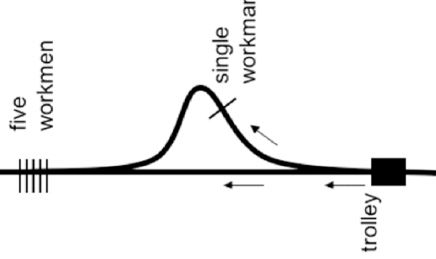]|<center>**.green[✓]**|<center>**.red[✗]**| |The loop weight|.less-tiny-picture[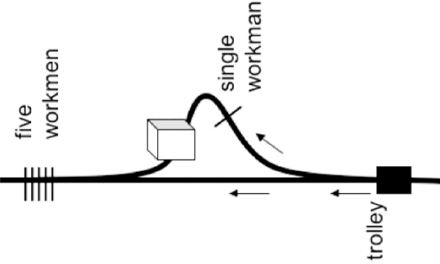]|<center>**.red[✗]**|<center>**.red[✗]**| |The obstacle collide|.tiny-picture[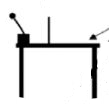]|<center>**.red[✗]**|<center>**.green[✓]** |The obstacle push|.tiny-picture[]|<center>**.green[✓]**|<center>**.green[✓]**| --- # The trolley problem .right-column-big[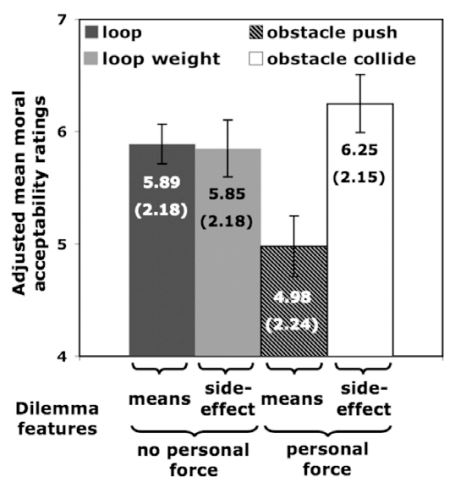] .left-column-small[#### Results - Intentional acts were rated as less morally acceptable - Intentional and personal force combined made for especially low moral acceptability ratings ] --- # The trolley problem #### Discussion - Individuals find harmful actions the least morally acceptable when - A person uses personal force (e.g., harms them directly with their hands or an object) AND - A person uses someone as a means to an end (i.e., good consequences should not justify evil means) --- # Abstract moral principles .footnote[Cushman et al. (2006)] The **rationalist model** of moral judgment says that individuals are *consciously aware* of the reasoning behind their moral decisions. ####Research question What principles do people tend to use to justify their answers to moral dilemmas? --- # Abstract moral principles .footnote[Cushman et al. (2006)] - Cushman et al. (2006) varied moral scenarios on three principles and asked people to *justify* their answers: - **The action principle**: It's morally worse if harm is caused by action rather than inaction. - **The intention principle**: It's morally worse if harming someone is a means to accomplish a goal than if harm occurs as a side effect of the goal. - **The contact principle**: It's morally worse to use physical contact to harm than it is to harm someone without using physical contact. --- # Abstract moral principles .footnote[Cushman et al. (2006)] <center><b>Action, intended harm, no contact </b></center> > .smaller[*Is it permissible for Evan .highlight-blue[to pull a lever] that drops a man off a footbridge and in front of a moving boxcar in order to cause the man to fall and be hit by the boxcar, thereby slowing it and saving five people ahead on the tracks?*] <center><b>Omission, intended harm, no contact</b> </center> > .smaller[*Is it permissible for Jeff .highlight-blue[not to pull a lever] that would prevent a man from dropping off a footbridge and in front of a moving boxcar in order to allow the man to fall and be hit by the boxcar, thereby slowing it and saving five people ahead on the tracks?*] --- # Abstract moral principles .footnote[Cushman et al. (2006)] The justifications were coded for: - **Sufficiency**: the subject gave a difference between the two cases that accounted for their judgment - **Failure**: the subject gave a difference between the two cases that could not account for their judgment - **Uncertainty**: the subject was unsure about how to justify their responses - **Denial**: the subject denied that they gave different responses - **Alternative explanation**: the subject gave an alternative explanation (e.g., they clicked the wrong button) --- # Abstract moral principles .footnote[Cushman et al. (2006)] .smallish-centered-picture2[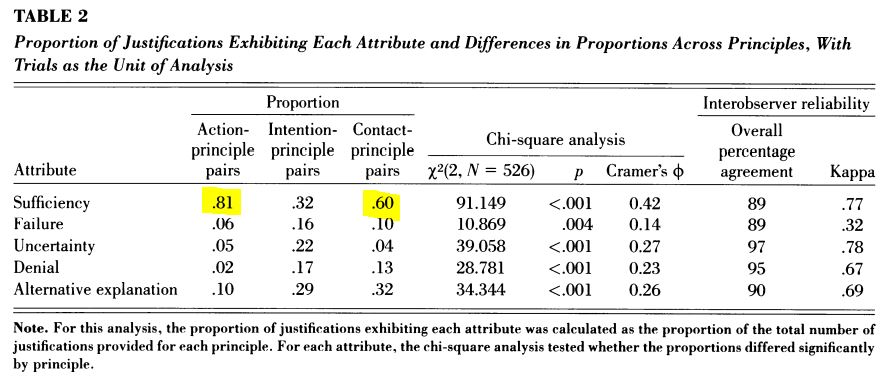] .smaller[<br><br><br><br><br><br><br><br> - Individuals correctly used the the action principle (it is worse to act than not act) and contact principle (it is worse to harm someone with physical contact than without) but not the intention principle (it's worse to harm someone as a means to an end than as a side effect)] --- # Normative theories .footnote[Aktas et al. (2017)] Aktas et al. (2017) gave participants four moral dilemmas and had them choose whether the action to save the five people was "right" or "wrong" #### Scenarios 1. The switch trolley dilemma (impersonal) 2. The footbridge trolley dilemma (personal) 3. Organ transplant (impersonal) 4. Organ transplant (personal) ??? Organ transplant personal -- a surgeon kills one patient and harvests their organs to save 5 Organ transplant impersonal -- a surgeon allows a nurse to kill a patient and then harvests their organs to save 5 --- # Normative theories .footnote[Aktas et al. (2017)] Additionally, participants were given five choices to justify their right or wrong judgment - **Amoral**: Moral reasons did not play an important role in my judgment - **Deontology**: Intentionally harming an innocent person is against fundamental moral rules and is thus unacceptable regardless of its intended consequences - **Utilitarianism**: Moral action is what ensures the well-being of the maximum number of people --- # Normative theories .footnote[Aktas et al. (2017)] Additionally, participants were given five choices to justify their right or wrong judgment - **Virtue-ethical**: Someone who intentionally harms an innocent person cannot be moral - **Fatalistic**: It is wrong to interfere with consequences that arise as a result of the natural course of events no matter what the ensuing harm is --- # Normative theories .footnote[Aktas et al. (2017)] .pull-left[#### Results - The table describes which normative moral theories individuals used to justify their choices") .dq[What patterns <br>do you notice?]] .pull-right[ 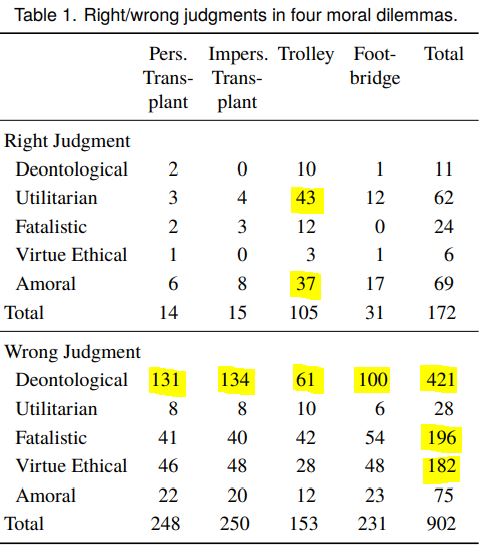] --- # Normative theories .footnote[Aktas et al. (2017)] .pull-right[] .pull-left[#### Results .smaller[- When the action was considered "right," people tended to not see the situation as moral or they gave a utilitarian justification - When the action was considered "wrong", people tended to choose a deontological justification] ] ??? This study was done on predominately muslim participants (the study was done in Turkey) Many gave utilitarian/ amoral explanations for the trolley dilemma --- # The rationalist model .footnote[Haidt (2001)] Let's revisit the rationalist model of moral judgment  Many philosophers and psychologists have argued that *affect* has a more direct role in determining a moral judgment than this model suggests --- # Affect and moral judgments .footnote[Greene et al. (2001)] #### Method Researchers gave participants moral-personal dilemmas (e.g., footbridge trolley dilemma), moral-impersonal dilemmas (e.g., the switch trolley dilemma), and non-moral dilemmas (e.g., choose between two coupons to use at a store) - They then recorded their brain activity using fMRI --- # Affect and moral judgments .footnote[Greene et al. (2001)] .pull-left[#### Results - Moral-personal dilemmas involved areas of the brain associated with *emotion* - Moral-impersonal and non-moral dilemmas involved areas of the brain associated with *working memory*] .pull-right[ 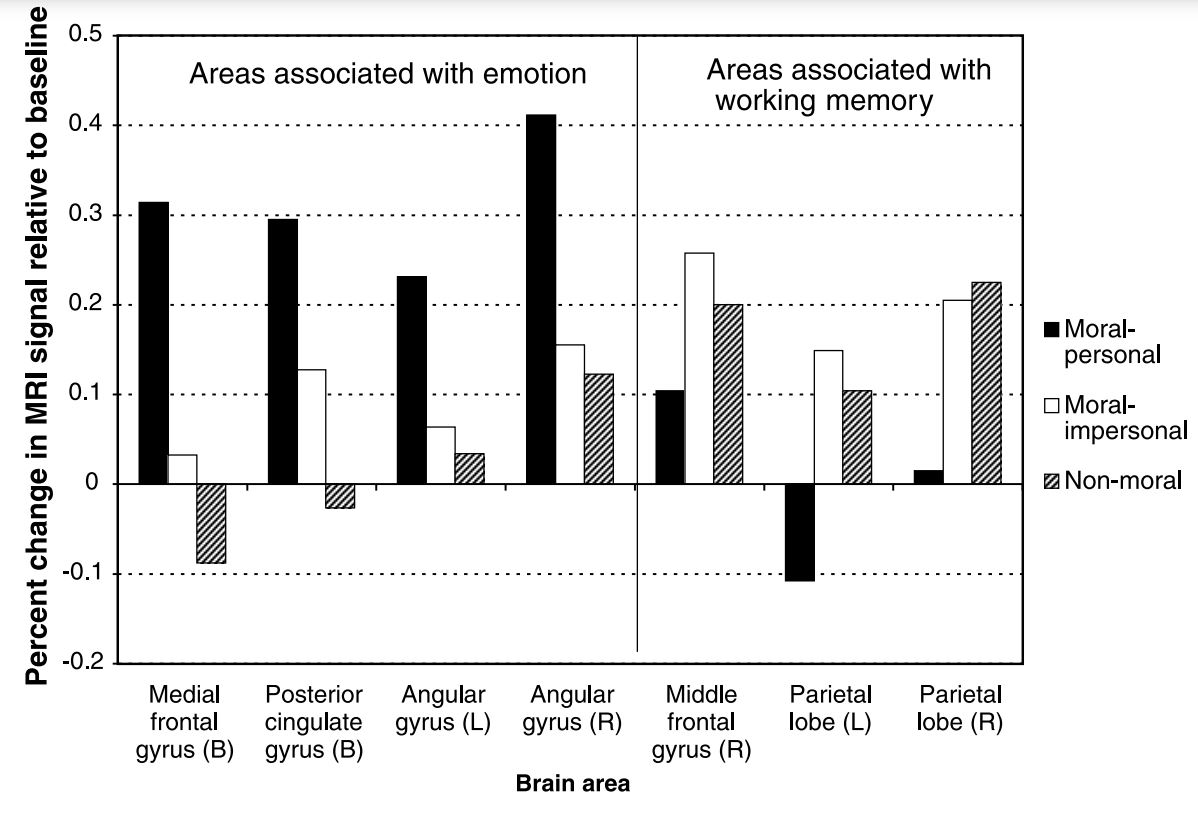] ??? They also found that solving moral dilemmas involved the same brain areas that are used in a stroop task, whether automatic process are being influenced/override by conscious processing --- # Affect and moral judgments .footnote[Greene et al. (2001)] .pull-left[#### Results - Moral-personal dilemmas involved areas of the brain associated with *emotion* - Moral-impersonal and non-moral dilemmas involved areas of the brain associated with *working memory*] .dq[.smaller[Given this finding, name a group of people you think would consider it is *morally right* to push the man off the bridge?]] --- #Affect and moral judgments .footnote[Koenigs et al. (2007); Cima et al. (2010); Bartels & Pizzaro (2011)] #### Bridge pushers .smaller[- Individuals who have *damage to the ventromedial prefrontal cortex* (VMPC), an area involved in generating emotions - Psychopaths (individuals who have deficits in emotional processing and inhibitory control) - Utilitarians/ consequentialists (individuals who philosophize that the morality of an action should be judged on the consequences of the action, i.e., their moral philosophy requires them to suppress emotional responses)] Based on these findings, emotion may play a more **direct role** in moral reasoning than the rationalist model suggests --- # Summary - Individuals find harmful actions much less morally acceptable when personal force is involved and when a person is using someone as a means to an end - Some but not all moral reasoning is conscious; we cannot always justify our moral judgments - Individuals prefer to endorse deontology over other moral philosophies - Emotion plays an important role in moral judgments; without emotional capabilities, we reason that it is moral to use others to achieve the greater good .highlight-blue[Next class]: intuitionism